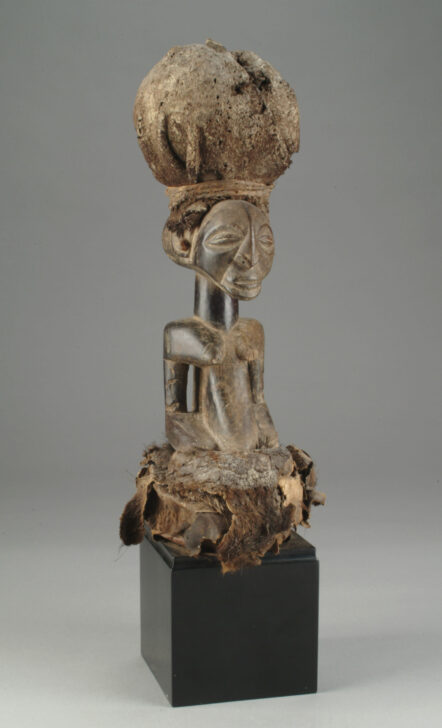Power Figure
Kusu

Description
Subject Matter:
This power figure, or kakudji, is attributed to the Kusu from the Democratic Republic of the Congo. The term kakudji refers to a vast genre of visual forms that are seen as receptacles or vessels of spirit beings; these forms can vary from being janus-faced, attached to a calabash, or carried as a portable amulet.
Spiritual mediums prescribed and consecrated specific kakudji to meet the particular needs of the owner and his family, including healing of the ill or infertile and ensuring success and safety in hunting. In this way, kakudji acted as visual reminders to the community that their deceased ancestors were continually protecting and assisting them. Kept privately in the home and safeguarded by the head of the family, the figures were passed down from father to son and could last for several generations.
This particular kakudji is emblematic of the northern style of Kusu woodcarving. Its large belly suggests pregnancy and therefore evokes maternity, fecundity, procreation, and the continuation of the family line. Most remarkable, however, is the massive animal skin balloon resting on top of the female’s head; this pouch, along with its embedded horn, contains ingredients specially crafted by the medium to activate and energize the spirit within. The crown of the head, and to be more precise, the fontanelle, is regarded as the site of communication with spirit entities.
Reference:
Maurer, Evan M. and Niangi Batulukisi. Spirits Embodied: Art of the Congo, Selections from the Helmut F. Stern Collection. Minneapolis: The Minneapolis Institute of Arts, 1999.
Physical Description:
This wooden figure depicts a female with a strikingly large, balloon-shaped animal skin sack tied above the crown of her head. An animal horn has been embedded within this massive sack. Representative of the northern style of Kusu carvings which is known to have sharp, angular forms, this kakudji features an ovoid head; a rounded, convex face and forehead; large ears; prominent cheekbones; coffeebean-shaped eyes within large ocular cavities; a well-defined, pointed nose; an elliptical mouth with slightly parted lips; a long, cylindrical neck; arms bent at the elbow, forming a 90-degree angle at the waist; and breasts that are situated nearly at shoulder level. The figure possesses a swollen belly, indicating pregnancy, and hence, representing the themes of maternity, fertility, and the continuation of the lineage. Animal skin enshrouds the female’s lower body. Tukula powder, derived from the camwood tree and used to consecrate kakudji, appears on the figure’s surface.
Usage Rights:
If you are interested in using an image for a publication, please visit https://umma.umich.edu/request-image/ for more information and to fill out the online Image Rights and Reproductions Request Form.